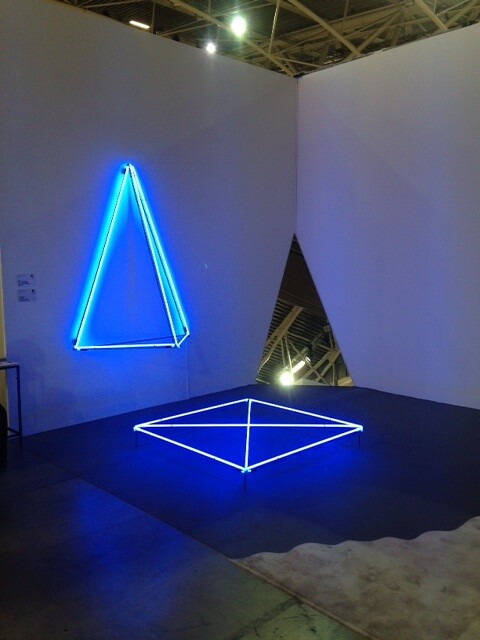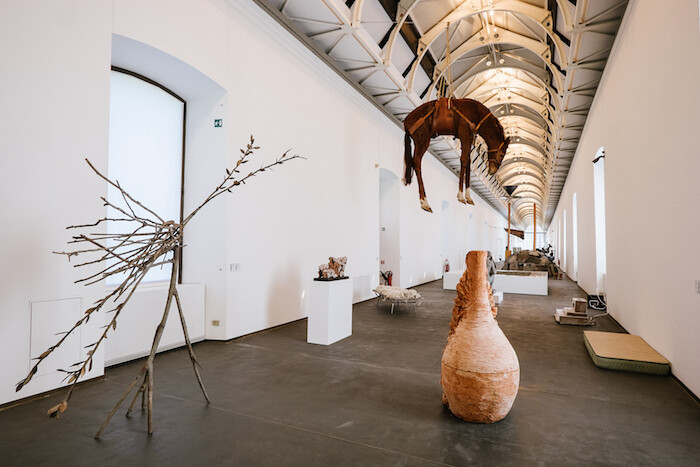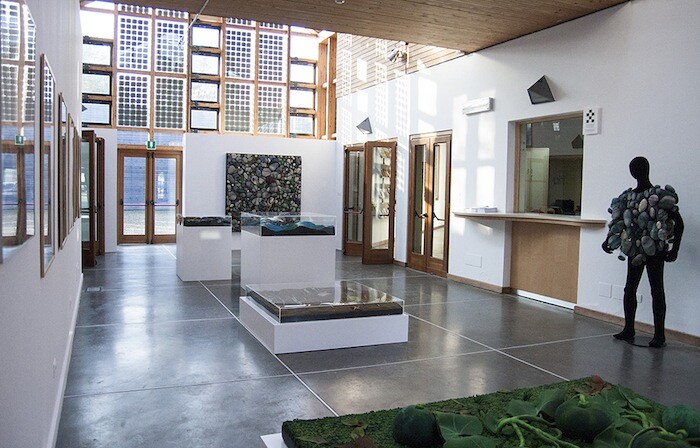It was difficult, having recently attended the opening of an art fair, to dispute Carolyn Christov-Bakargiev’s assertion that “we live in the age of oligarchs.” The newly appointed director of two of Turin’s most celebrated arts institutions1 told me, as we meandered through the halfway re-hung galleries of the Castello di Rivoli, that one consequence of the international proliferation of private museums showcasing collections amassed by a small number of competitive collectors “with little interest in the past” is a phenomenon akin to cultural-historical amnesia. It is her responsibility, she said, to use the extensive public collections at her disposal to foster interactions between past and present, teasing out the connections between different eras rather than reinforcing the illusion that our times (and by extension our artists) are divorced from the past.
The architecture of Turin provides a neat analogue for the productivity of such intergenerational dialogue. My taxi from Castello di Rivoli—situated in the former residence of the Royal House of Savoy on the city’s picturesque outskirts—to Artissima—which occupies a Renzo Piano-designed conference center in the heart of what was once the city’s industrial district—passes ancient Roman settlements, Guarini’s dome for the Chiesa di San Lorenzo, and, adjacent to the fair, the splendid Lingotto FIAT factory designed by Giacomo Mattè-Trucco in the Rationalist style, complete with undulating rooftop racetrack. In purely art historical terms, too, it seems appropriate that the spiritual home of Arte Povera, Alighiero Boetti, and Italy’s historical avant-garde should position itself as the city in which contemporary art draws upon the past to move into the future.
This creative confusion of tenses was much in evidence at the fair, which presented two sections entitled “Present Future” and “Back to the Future.” The latter declares itself to be “dedicated to research,” on this occasion re-examining the period 1975–1985, but the bustle only serves to remind the visitor that the juxtaposition of past and present can be a market-based strategy as much as a purely curatorial one, premised upon the mutually beneficial exchange of canonical gravitas and contemporary glitz. Among the twentieth-century vanguards to have benefited from a recent critical and commercial resurgence is ZERO, represented here by Nanda Vigo—the curator of an influential exhibition of ZERO artists at Lucio Fontana’s Milanese studio in 1965—in a joint presentation by Ca’ di Fra’, Milan, and Allegra Ravizza, Lugano. The neon wall piece, standing sculpture, and triangular mirror that comprise Vigo’s Frammenti di Riflessione (1979) elegantly conflate minimalist austerity with the weightless anti-materialism typical of the movement. Elsewhere in the same section, London’s White Rainbow shows a two-part photographic self-portrait by Japanese conceptualist—and founder of the Kobe chapter of ZERO—Chu Enoki (Going to Hungary with HANGARI, 1977). Inspired by a visit to the retrospective of Marcel Duchamp’s work at the newly opened Centre Pompidou, Enoki shaved one side of his body (“Hangari” meaning “half-shaved” in Japanese) in homage to the French artist, who had cut a star symbol into his hair on first visiting the United States (a further series of photographs shows the asymmetrical Enoki sightseeing in various European cities). The work is—in its execution and its aesthetic—unmistakeably of its time, but it’s a neat example of the currents of influence that run through even the most idiosyncratic practices.
History and place combine in Hayv Kahraman’s series of large-scale paintings “How Iraqi Are You?” (2015), exhibited by Dubai’s The Third Line gallery in the Present Future section. Appropriating the visual language of the Maqamat al Hariri, a twelfth-century Iraqi manuscript illustrating scenes from everyday life, Kahraman’s paintings memorialize her childhood in Baghdad and Sweden. Yet they also serve as something like an instruction manual to the newly displaced, in which the artist is depicted in the process of making such adjustments to the local culture as learning the language. A refugee’s attempt to constitute a new identity by combining the fragments of a culture from which she is exiled by both time and place with the circumstances of her new life feels remarkably pressing, even amidst the frivolities of an art fair.
Beyond Artissima, the compulsion to play eras and styles against each other was also apparent in “Tutttovero” [sic], a wildly eclectic, citywide exhibition spanning four venues. Curated by Francesco Bonami, the thematic show drew on four of Turin’s most prestigious collections—Galleria Civica d’Arte Moderna e Contemporanea (GAM), the Fondazione Sandretto Re Rebaudengo, the Fondazione Merz, and the Castello di Rivoli—to address the theme of truth though art accumulated in Turin over the past two centuries.2 The presentation at GAM was soundtracked by John Baldessari’s deadpan video work I Am Making Art (1971)—in which the artist adopts a series of unchallenging physical poses while intoning said statement as mantra or defence. Yet even this broad invocation could not force coherence upon so disparate a selection, and works including Giovanni Anselmo’s Torsione (1968) were overwhelmed by their proximity to a muddle of objects ranging from Thomas Demand’s Grotto (2006) to nineteenth-century portraits.
More successful was the remarkable installation at Castello di Rivoli, which brought around 50 sculptures into the long, narrow room that once served as the Savoy family’s picture gallery. Maurizio Cattelan’s Novecento (1997) and Claes Oldenburg and Coosje van Bruggen’s Architectural Fragments (1985) dangled precariously from the ceiling; Michelangelo Pistoletto’s Venere degli stracci [Venus of the Rags] (1967) piled up against the wall; Gilberto Zorio’s giant, swinging broomstick Barca nuragica (2000) swept over the heads of visitors. Yet for all that “Tutttovero” promised, in Bonami’s curatorial statement, to “explore [the notion of truth] at a time when augmented reality and the faster communication of facts raises doubts on the credibility of any news,” the display was more effective as sheer spectacle. Indeed, it seems so obvious that art has always had a slantwise relationship to truth, irrespective of the speed at which news travels, that it was hard to find a firm theoretical foothold amidst the pageant.
A more effective symbol of the unreliability of the image was provided, albeit incidentally, by the banner outside Parco Arte Vivente, host to “Earthrise: Pre-Ecological Visions in Italian Art 1967-73.” Curated by Marco Scottini and inspired by William Anders’s famous first photo of the Earth from the moon, Earthrise (1968), the exhibition presents a selection of pioneering Italian artists whose work during this period might be seen to have anticipated contemporary approaches to ecological and environmental art. Yet the written material nowhere acknowledges the misleading history of the titular photograph, which was not in fact taken from the surface of the moon (as one might assume) but in the course of Apollo 8’s orbit around it. Prior to its publication, the picture was turned through 90 degrees so as to satisfy the human assumption that the ground should run along the bottom of the frame, beneath one’s feet.3 It’s a neat, if incidental, illustration of precisely the skewed relationship of image to truth that “Tutttovero” sought to interrogate.
Featuring work made by Piero Gilardi, Ugo La Pietra, radical architecture group 9999, and Gianfranco Baruchello around the end of a turbulent decade, the exhibition proposes that Anders’s image of the Earth as a glowing speck precipitated a dramatic shift in human perspective.4 With the recognition of our planet’s vulnerability came a new humility, a “return to the earth” that acknowledged and sought to counteract the widening gap between headlong industrialization and ecological sustainability: the 1971 manifesto published by 9999, for instance, warned that the “ecosystem is at crisis point” and urged its readers to respond creatively. It was a challenge taken up by Baruchello’s experimental farm Agricola Cornelia (1973–81) and La Pietra’s urban vegetable patches (both of which are documented here). “Return” is figured as an affirmative, progressive action, and it’s hard not to notice how much more pertinent to our time are these experiments in living than shinier, newer baubles on display elsewhere in the city. Sometimes, it seems, we might have to look backwards to move forwards.
Carolyn Christov-Bakargiev formally takes over as the director of Turin’s Galleria Civica d’Arte Moderna e Contemporanea (GAM) and Castello di Rivoli – Museo d’Arte Contemporanea on January 1, 2016.
By the time of my visit, the iterations of “Tutttovero” at the Merz and Re Rebaudengo foundations had closed.
James Bridle addresses this in his short essay “Armies Will Vanish,” http://www.thewhitereview.org/white-screen/armies-will-vanish/.
This shift in perspective is echoed by Katie Paterson’s Timepieces (Solar System) (2014)—on view at Parafin, London in the Present Future section of Artissima—which comprises nine clocks telling the time on our solar system’s planets.












